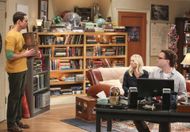The Big Bang Theory beginning any other way than Sheldon, Leonard, and Penny tumbling into an unconventional friendship across the hallway is unimaginable. From its humble beginnings, the series became a pop culture phenomenon, melding geek culture with classic sitcom tropes throughout its 12 seasons. However, the show did almost start with an entirely different tone. An unaired pilot— all but hidden from public cinema- presented a much darker take of the storyline.
In that early draft, the characters were coarsened, the tone was cut with more realism, and the apartment? Stuffy, unkempt, and much more pragmatic. Sheldon didn’t embody the role’s fastidious germophobe traits the way viewers have come to associate him with on the show. He drank, dated, and was socially awkward- yet, less than what we know him to be now. Penny didn’t exist. Instead, there was Katie who is a cynical and emotionally closed off woman that crashes with the guys due to tough unforeseen circumstances.
The preliminary set-up resolved a problematic aspect of sitcoms: many shows overly glamorize the living conditions of economically depressed characters. On the contrary, Sheldon and Leonard's living situation was in accordance with their academic salaries: dingy, cheap, and suffocatingly cluttered. Unfortunately, that realism also stripped the show of warmth, relatability, and character interactions that would come to shape and define the series later on.
When revising the pilot, the creators opted for something more stylized—and that’s the version that became popular.
Changing the apartment changed everything

Perhaps the initial setup of the apartment was functional, but did not suit the needs of a multi-season sitcom. The space was small, lacked windows, and felt visually like an independent film rather than a network comedy. After making some changes to the show, Sheldon and Leonard’s new apartment was brighter, larger, and filled with comic books and collectibles that complemented their character and provided a friendlier aesthetic for the audience.
It also aided in defining how the characters interacted with one another. For example, Sheldon is portrayed as being obsessed with order and cleanliness – traits that would have been impossible to portray in the original version’s dirty setting. However, the upgraded apartment not only makes sense cinematically, but also became one of the most recognizable sets in television comedy.
The Penny problem that the set solved for The Big Bang Theory

In the unaired pilot of The Big Bang Theory, Katie was living on the streets and had no option but to move in with the guys. While that scenario made for immediate engagement, it also added a brand of friction that disturbed the comedic rhythm. Giving her an apartment — and reimagining her as Penny — gave the writers room to balance romance and conflict and develop Leonard’s and her relationship into a more organic one with flirtation and friction that could endure multiple seasons.
Also having Penny live across the hall accentuated the meshing of worlds that the show emphasized: The Big Bang Theory featured two worlds very different next to each other trying to figure the other one out. It broadened the plot both visually and emotionally, allowing Penny to seamlessly come into the scene, while the apartment itself emphasized the shift and became the focal point where all the cast interacted.
